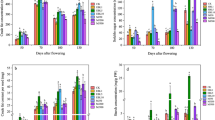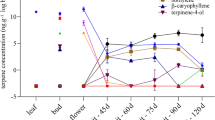Abstract
Pharmaceutical 1,8-cineole oil is commercially harvested from Eucalyptus polybractea R.T. Baker grown in short rotation coppice cultivation. Harvests occur throughout the year, with no consideration given to the proportion of leaves present at different ontogenetic stages, and the effect leaf ontogeny may have on harvested oil quality and quantity. To determine the optimal leaf stage to harvest pharmaceutical-grade oil, we quantified the relationship between leaf ontogeny and foliar oil quantity and quality, secretory cavity size, and abundance along branches of two E. polybractea clones. The results show that the desirable attributes of oil yield and 1,8-cineole proportion both reach their maximum in fully expanded leaves and that this coincides with maximum secretory cavity size. Across all leaf ages the amount of various monoterpenes were highly correlated with 1,8-cineole, suggesting a single, multi-product monoterpene synthase may be responsible. In the very young leaves, sesquiterpenes such as β-elemene were the most abundant constituents of the essential oil. This study suggests that there may be differential transcriptional regulation of mono- and sesquiterpene synthases with leaf ontogeny such that sesquiterpene biosynthesis is at a maximum only in young leaves, and that monoterpene biosynthesis dominates during leaf and concomitant cavity expansion. Given E. polybractea leaves are produced during major seasonal flushes, there are times throughout the year when the numbers of young leaves with inferior oil quantity and quality are likely to be proportionally decreased. Therefore harvesting times could be manipulated to take advantage of such times and ensure abundant high quality oil is harvested.






Similar content being viewed by others
References
Adzet T, Ponz R, Wolf E, Schulte E (1992) Content and composition of M. officinalis oil in relation to leaf position and harvest time. Planta Med 58:562–564
Batish DR, Singh HP, Kohli RK, Kaur S (2008) Eucalyptus essential oil as a natural pesticide. For Ecol Manage 256:2166–2174
Brophy JJ, House APN, Boland DJ, Lassak EV (1991) Digests of the essential oils of 111 species from northern and eastern Australia. In: Boland DJ, Brophy JJ, House APN (eds) Eucalyptus leaf oils. Inkata Press, Melbourne, pp 29–155
Brun N, Colson M, Perrin A, Voiron B (1992) Chemical and morphological studies of the effects of ageing on monoterpene composition in Mentha × piperita leaves. Can J Bot 69:2271–2278
Cai Y, Jia J-W, Crock J, Lin Z-X, Chen X-Y, Croteau R (2002) A cDNA clone for b-caryophyllene synthase from Artemisia annua. Phytochemistry 61:523–529
Chen F, Ro D-K, Petri J, Gershenzon J, Bohlmann J, Pichersky E, Tholl D (2004) Characterization of a root-specific Arabidopsis terpene synthase responsible for the formation of the volatile monoterpene 1,8-cineole. Plant Physiol 135:1956–1966
Cheng A-X, Xiang C-Y, Li J-X, Yang C-Q, Hu W-L, Wang L-J, Lou Y-G, Chen X-Y (2007) The rice (E)-β-caryophyllene synthase (OsTPS3) accounts for the major inducible volatile sesquiterpenes. Phytochemistry 68:1632–1641
Coppen JW (2002) Production, trade and markets for eucalyptus oils. In: Coppen JW (ed) Eucalyptus: the genus Eucalyptus, vol 22. Taylor & Francis, London
Davis GR (2002) Cultivation and production of eucalypts in Australia: with special reference to the leaf oils. In: Coppen JW (ed) Eucalyptus: the genus Eucalyptus, vol 22. Taylor & Francis, London, pp 183–201
Demissie ZA, Cella MA, Sarker LS, Thompson TJ, Rheault MR, Mahmoud SS (2012) Cloning, functional characterization and genomic organisation of 1,8-cineole synthases from Lavandula. Plant Mol Biol 79:393–411
Doran JC (1991) Commercial sources, uses, formation, and biology. In: Boland DJ, Brophy JJ, House APN (eds) Eucalyptus leaf oils, use, chemistry, distillation and marketing. Inkarta Press, Melbourne, pp 11–28
Doran JC, Bell RE (1994) Influence of non-genetic factors on yield of monoterpenes in leaf oils of Eucalyptus camaldulensis. New Forest 8:363–379
Dudai N, Lewinsohn E, Larkov O, Katzir I, Ravid U, Chaimovitsh D, Sa’adi D, Putievsky E (1999) Dynamics of yield components and essential oil production in a commercial hybrid sage (Salvia officinalis × Salvia fruticosa cv. Newe Ya’ar No. 4). J Agric Food Chem 47:4341–4345
Dudai N, Larkov O, Ravid U, Putievsky E, Lewinsohn E (2001) Developmental control of monoterpene content and composition in Micromeria fruticosa (L.) Druce. Ann Bot 88:349–354
Forrest GI (1980) Seasonal and spatial variation in cortical monoterpene composition of Sitka spruce oleoresin. Can J For Res 10:452–457
Fuchs CH (1963) Fuchsin staining with NaOH clearing for lignified elements of whole plants or plants organs. Biotech Histochem 38:141–144
Gershenzon J (1994) Metabolic costs of terpenoid accumulation in higher plants. J Chem Ecol 20:1281–1328
Goodger JQD, Woodrow IE (2009) The influence of ontogeny on essential oil traits when micropropagating Eucalyptus polybractea. For Ecol Manage 258:650–656
Goodger JQD, Woodrow IE (2012) Genetic determinants of oil yield in Eucalyptus polybractea R.T. Baker. Trees 26:1951–1956
Goodger JQD, Heskes AM, King DJ, Gleadow RM, Woodrow IE (2008) Micropropagation of Eucalyptus polybractea selected for key essential oil traits. Funct Plant Biol 35:247–251
Goodger JQD, Cao B, Jayadi I, Williams SJ, Woodrow IE (2009) Non-volatile components of the essential oil secretory cavities of Eucalyptus leaves: discovery of two glucose monoterpene esters, cuniloside B and froggattiside A. Phytochemistry 70:1187–1194
Goodger JQD, Connolly CA, Woodrow IE (2007) Examination of the consistency of plant traits driving oil yield and quality in short-rotation coppice cultivation of Eucalyptus polybractea. For Ecol Manage 250:196–205
Goodger JQD, Heskes AM, Mitchell MC, King DJ, Neilson EH, Woodrow IE (2010) Isolation of intact sub-dermal secretory cavities from Eucalyptus. Plant Methods 6:20
Hose S, Zanglein A, Van Den Berg T, Schultze W, Kubeczka KH, Czygan FC (1997) Ontogenetic variation of the essential leaf oil of Melissa officinalis L. Pharmazie 52:247–253
Hrutfiord BF, Hopley SM, Gara RI (1974) Monoterpenes in sitka spruce: within tree and seasonal variation. Phytochemistry 13:2167–2170
Kampranis SC, Ioannidis D, Purvis A, Mahrez W, Ninga E, Katerelos NA, Anssour S, Dunwell JM, Degenhardt J, Makris AM, Goodenough PW, Johnson CB (2007) Rational conversion of substrate and product specificity in a Salvia monoterpene synthase: structural insights into the evolution of terpene synthase function. Plant Cell 19:1994–2005
Keszei A, Brubaker CL, Carter R, Köllner T, Degenhardt J, Foley WJ (2010) Functional and evolutionary relationships between terpene synthases from Australian Myrtaceae. Phytochemistry 71:844–852
King DJ, Gleadow RM, Woodrow IE (2006) Regulation of oil accumulation in single glands of Eucalyptus polybractea. New Phytol 172:440–451
Kulheim C, Yeoh S-H, Maintz J, Foley WJ, Moran GF (2009) Comparative SNP diversity among four Eucalyptus species for genes from secondary metabolite biosynthetic pathways. BMC Genomics 10:452
Langenheim JH (1994) Higher plant terpenoids: a phytocentric overview of their ecological roles. J Chem Ecol 20:1223–1280
List S, Brown PH, Walsh KB (1995) Functional anatomy of the oil glands of Melaleuca alternifolia (Myrtaceae). Aust J Bot 43:629–641
Maarse H, Kepner RE (1970) Changes in composition of volatile terpenes in Douglas fir needles during maturation. J Agric Food Chem 18:1095–1101
McConkey ME, Gershenzon J, Croteau RB (2000) Developmental regulation of monoterpene biosynthesis in the glandular trichomes of peppermint. Plant Physiol 122:215–223
Roeder S, Hartmann AM, Effmert U, Piechulla B (2007) Regulation of simultaneous synthesis of floral scent terpenoids by the 1,8-cineole synthase of Nicotiana suaveolens. Plant Mol Biol 65:107–124
Russell M, Southwell I (2002) Monoterpenoid accumulation in Melaleuca alternifolia seedlings. Phytochemistry 59:709–716
Schmid C, Steinbrecher R, Ziegler H (1992) Partition coefficients of plant cuticles for monoterpenes. Trees 6:32–36
Schönwitz R, Lohwasser K, Kloos M, Ziegler H (1990) Seasonal variation in the monoterpenes in needles of Picea abies (L.) Karst. Trees 4:34–40
Steele CL, Katoh S, Bohlmann J, Croteau R (1998) Regulation of oleoresinosis in grand fir (Abies grandis). Differential transcriptional control of monoterpene, sesquiterpene, and diterpene synthase genes in response to wounding. Plant Physiol 116:1497–1504
Tholl D, Chen F, Petri J, Gershenzon J, Pichersky E (2005) Two sesquiterpene synthases are responsible for the complex mixture of sesquiterpenes emitted from Arabidopsis flowers. Plant J 42:757–771
Turner GW, Gershenzon J, Croteau RB (2000) Distribution of peltate glandular trichomes on developing leaves of peppermint. Plant Physiol 124:655–663
Von Rudloff E (1975) Seasonal variation in the terpenes of the foliage of black spruce. Phytochemistry 14:1695–1699
Warren RG (1991) Practical aspects of marketing essential oils. In: Boland DJ, Brophy JJ, House APN (eds) Eucalyptus leaf oils. Inkata Press, Melbourne, pp 195–202
Wilderman PR, Xu M, Jin Y, Coates RM, Peters RJ (2004) Identification of syn-pimara-7,15-diene synthase reveals functional clustering of terpene synthases involved in rice phytoalexin/allelochemical biosynthesis. Plant Physiol 135:2098–2105
Wildy DT, Pate JS (2002) Quantifying above- and below-ground growth responses of the Western Australian oil mallee, Eucalyptus kochii subsp. plenissima, to contrasting decapitation regimes. Ann Bot 90:185–197
Wildy DT, Bartle JR, Pate JS, Arthur DJ (2000) Sapling and coppice biomass production by alley-farmed ‘oil mallee’ Eucalyptus species in the Western Australian wheatbelt. Aust For 63:147–157
Wirthensohn MG, Sedgley M (1996) Epicuticular wax structure and regeneration on developing juvenile Eucalyptus leaves. Aust J Bot 44:691–704
Acknowledgments
The authors thank Mr. Peter Abbott of FGB Natural Products for access to the plantation and Metabolomics Australia for GC–MS assistance. JQDG and IEW were supported by a grant from the Australian Research Council (Project DP1094530).
Conflict of interest
The authors declare that they have no conflict of interest.
Author information
Authors and Affiliations
Corresponding author
Additional information
Communicated by A. Franco.
Rights and permissions
About this article
Cite this article
Goodger, J.Q.D., Mitchell, M.C. & Woodrow, I.E. Differential patterns of mono- and sesquiterpenes with leaf ontogeny influence pharmaceutical oil yield in Eucalyptus polybractea R.T. Baker. Trees 27, 511–521 (2013). https://doi.org/10.1007/s00468-012-0804-6
Received:
Revised:
Accepted:
Published:
Issue Date:
DOI: https://doi.org/10.1007/s00468-012-0804-6




